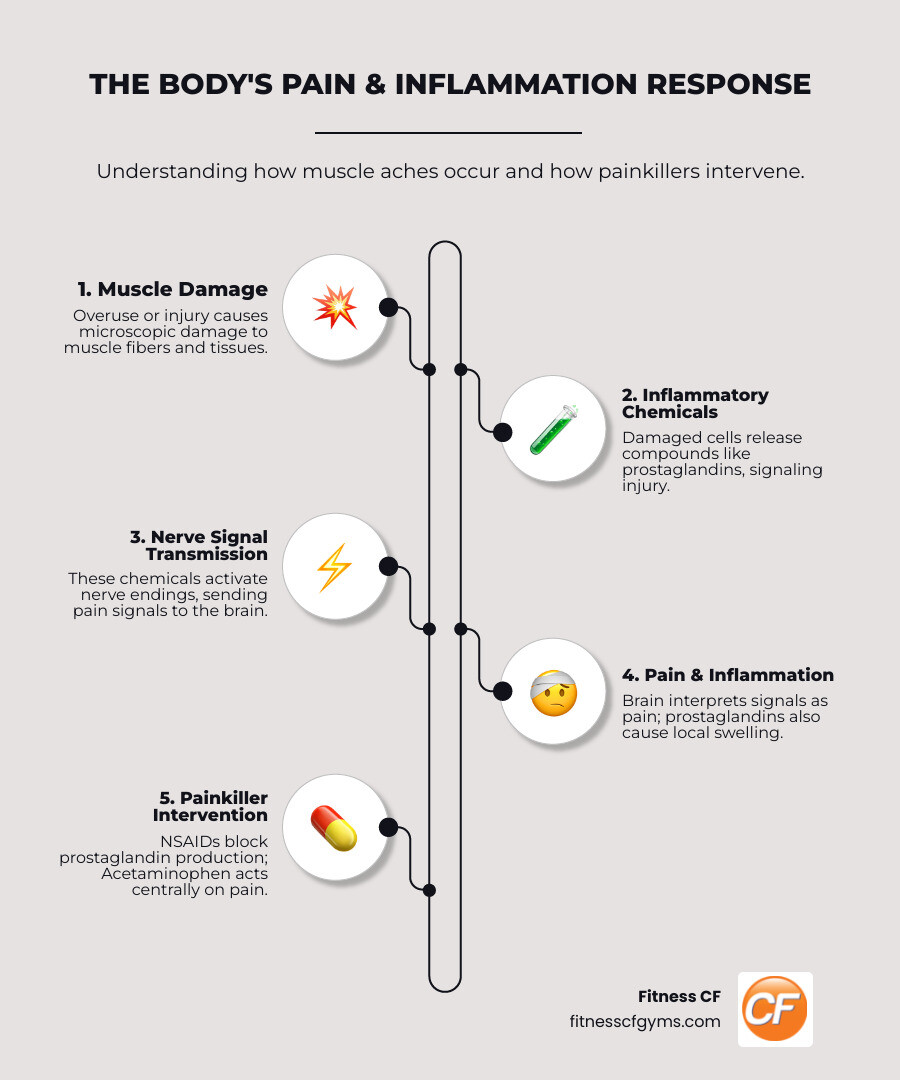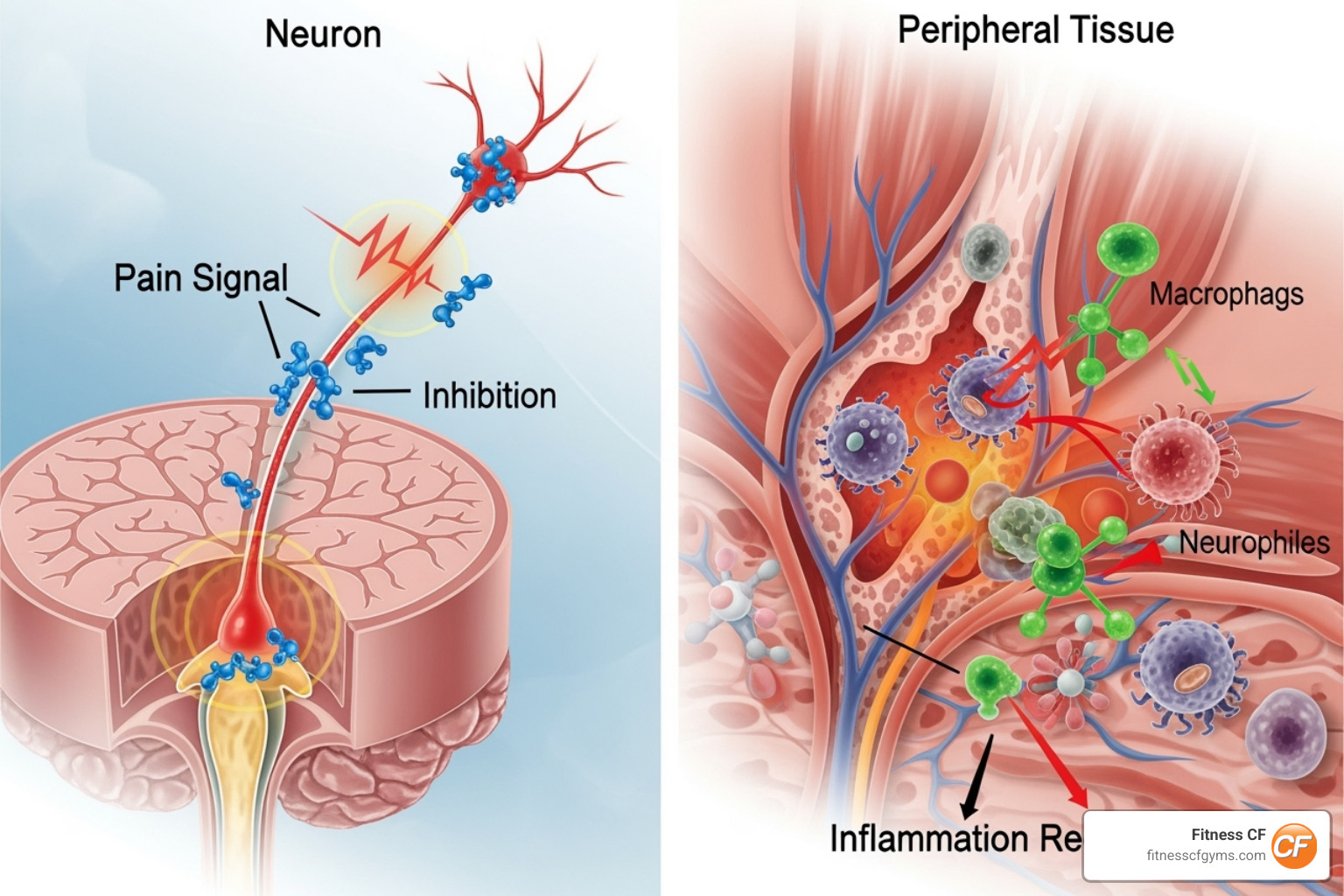Why Muscles Ache and How to Find Relief
Painkillers for muscle aches are medicines that reduce or relieve discomfort from sore muscles, whether from workouts, daily activities, or minor injuries. Here are your main options:
Top Painkillers for Muscle Aches:
- Acetaminophen (Tylenol) – Best for general muscle pain without swelling
- Ibuprofen (Advil, Motrin) – Best for muscle pain with inflammation from sports injuries
- Naproxen (Aleve) – Longer-lasting relief for muscle strains and inflammation
- Topical creams/gels – Direct application to sore muscles with fewer systemic side effects
Muscle aches happen for many reasons. Delayed Onset Muscle Soreness (DOMS) kicks in 24-48 hours after tough workouts. Overexertion from pushing too hard can leave you feeling stiff and sore. Minor strains from lifting heavy objects or sudden movements create targeted pain.
Your body uses pain as a signal system. It’s telling you to slow down, rest, or change what you’re doing. Listen to these signals – they help prevent bigger injuries down the road.
The good news? We have many relief options beyond just popping pills. This guide will help us choose the right painkiller for our specific situation and show us natural ways to speed up recovery.
I’m Pleasant Lewis, and I’ve spent over 40 years in the fitness industry helping people manage muscle soreness and recovery. Through my experience at fitness centers, I’ve learned that understanding painkillers for muscle aches is just one piece of the recovery puzzle. Let me walk you through everything you need to know to get from ache to awesome.

Choosing Your Relief: A Guide to Painkillers for Muscle Aches
When you wake up with sore muscles after yesterday’s workout, your body is actually telling you a story. That ache? It’s the result of your body’s natural response to tissue damage or overuse through inflammation. Understanding how painkillers for muscle aches work helps you choose the right relief for your specific situation.
Think of your body’s pain response like a fire alarm system. When muscle fibers get damaged or overworked, your body releases substances called prostaglandins. These hormone-like compounds act as messengers, signaling pain and contributing to swelling at the injury site.
Most pain relievers target special enzymes called COX enzymes – specifically COX-1 and COX-2. These enzymes are like the factory workers that produce prostaglandins. When pain medications block these enzymes, fewer prostaglandins get made, which means less pain and inflammation for you.
Here’s where it gets interesting: some medications work centrally (affecting pain signals in your brain), while others work peripherally (directly at the sore muscle site). This difference matters when choosing your relief strategy.

Acetaminophen: For Pain Without Swelling
Acetaminophen (you know it as Tylenol) takes a different approach than other painkillers for muscle aches. Instead of working at the injury site, it goes straight to headquarters – your brain and spinal cord. It blocks prostaglandin production in these central areas, essentially turning down your pain perception volume.
This makes acetaminophen perfect for general muscle soreness without obvious swelling or redness. Got those all-over aches after starting a new exercise routine? Acetaminophen can help. It’s also your go-to for headaches and fever that sometimes accompany muscle fatigue.
But here’s what you need to know: acetaminophen can be tough on your liver. While it’s generally safe when used correctly, taking more than recommended can cause serious liver damage. This is especially important because acetaminophen hides in many cold and flu medications.
Never exceed the maximum daily dose, and avoid it if you have liver problems or drink three or more alcoholic beverages daily. Always check labels carefully – you might be getting acetaminophen from multiple sources without realizing it. For detailed safety information, check out the FDA’s guidance on acetaminophen safety.
NSAIDs (Ibuprofen & Naproxen): For Pain with Inflammation
When your muscles are not just sore but also swollen, red, or warm, you need the heavy hitters: NSAIDs (Non-Steroidal Anti-Inflammatory Drugs). Ibuprofen (Advil, Motrin) and naproxen (Aleve) are your main options in this category of painkillers for muscle aches.
These medications work like skilled mechanics, blocking both COX-1 and COX-2 enzymes throughout your entire body. This stops prostaglandin production at the source, tackling both pain and inflammation head-on.
NSAIDs shine brightest for sports injuries, muscle strains, and workout-related soreness where inflammation plays a starring role. That pulled muscle from overdoing it on leg day? NSAIDs are your friend.
Ibuprofen versus naproxen comes down to convenience. Ibuprofen works faster but needs to be taken every 4-6 hours. Naproxen lasts longer, requiring only twice-daily dosing every 8-12 hours. Choose based on your schedule and pain pattern.
The trade-off? NSAIDs can irritate your stomach lining and, with long-term use, may increase heart attack or stroke risk. They’re also harder on your kidneys than acetaminophen. Older adults face higher risks with these medications.
If you have a history of stomach ulcers, heart disease, or kidney problems, talk to a healthcare professional before using NSAIDs regularly. For more detailed information, the American College of Rheumatology has excellent resources on understanding NSAIDs.
Topical Painkillers for Muscle Aches: Targeted Application
Sometimes you just want to treat the exact spot that hurts without affecting your whole body. That’s where topical painkillers for muscle aches become game-changers. These gels, creams, patches, and rubs deliver relief directly to your sore muscles through your skin.
Topical NSAIDs like diclofenac gel work just like their pill counterparts but with a major advantage: much less medication enters your bloodstream. This means fewer stomach, heart, or kidney concerns while still getting inflammation-fighting power where you need it most.
Other popular topical options include menthol and capsaicin rubs. Menthol creates that cooling sensation that distracts your brain from pain signals. Capsaicin (from chili peppers) works differently – it actually depletes the chemical that transmits pain signals, providing warming relief over time.
Some topical products contain lidocaine for localized numbing, perfect for those specific tender spots that won’t quit bothering you.
The beauty of topical treatments? Fewer systemic side effects and targeted action. They’re ideal for muscle strains, workout soreness, or any time you want effective relief without taking another pill. Just apply, rub in, and let them work their magic right where it hurts.
Beyond the Counter: When to See a Doctor for Muscle Pain
Sometimes our trusty over-the-counter painkillers for muscle aches just aren’t cutting it. When that happens, it’s time to have an honest conversation with a healthcare professional. I’ve seen too many people push through serious pain, thinking they’re being tough, when what they really need is proper medical care.
Signs of severe injury should send you straight to the doctor’s office (or emergency room). We’re talking about intense, unbearable pain that makes you want to curl up in a ball. Significant swelling that looks angry and won’t go down is another red flag. If you can see an obvious deformity in a limb or joint, or if you simply can’t move the affected body part, don’t wait – get help immediately.
Pain lasting over a week is your body’s way of saying “Hey, this isn’t just regular soreness anymore.” The FDA actually recommends checking with your healthcare provider before taking acetaminophen for more than ten days (or five days for children). That’s not just legal fine print – it’s solid medical advice.
When OTC options fail, it’s not a personal failure on your part. Sometimes our bodies need more sophisticated help, and there’s absolutely nothing wrong with seeking it. A doctor can dig deeper into what’s causing your pain and create a treatment plan that actually works.
Prescription-Strength Pain Relievers
When regular painkillers for muscle aches aren’t doing the job, your doctor has some powerful tools in their toolkit. Many NSAIDs like ibuprofen and naproxen come in much stronger prescription doses. Think of it as upgrading from a regular hammer to a sledgehammer – sometimes you need that extra force.
Muscle relaxants like cyclobenzaprine can be game-changers when muscle spasms are making your life miserable. These medications help break that awful cycle where pain causes spasms, which cause more pain, which cause more spasms. They’re typically used for short periods, but they can provide the relief you need to start healing properly.
For really stubborn or severe pain, doctors might suggest cortisone shots – powerful anti-inflammatory injections delivered right where you need them most. Nerve blocks are another option, where an anesthetic is injected near specific nerves to essentially turn off the pain signals. These treatments are usually handled by specialists and reserved for more serious conditions.
The Mayo Clinic has excellent information about making smart decisions with chronic pain medications: Chronic Pain: Medication Decisions.
Understanding Opioids and Their Risks
Let’s talk honestly about opioids – the most powerful pain medications available. These include drugs like oxycodone, hydrocodone, and morphine. They’re incredibly effective at stopping pain, but they’re rarely appropriate for typical muscle aches.
Opioids work by mimicking your brain’s natural pain-fighting chemicals called endorphins. They bind to special receptors and essentially tell your pain signals to take a hike. The problem? Your body gets used to them fast.
When prescribed for acute pain – like after surgery or a serious injury – opioids can be appropriate for a few days. But they’re almost never the right choice for regular muscle soreness or even chronic muscle pain. The high risk of addiction and dependence is real and scary. Your body can develop tolerance quickly, meaning you need more and more to get the same relief.
The overdose crisis in America is largely driven by opioid medications. These drugs cause more overdose deaths than any other type of medication. That’s why they’re truly a last resort for chronic pain and generally not suitable as painkillers for muscle aches.
If your doctor does prescribe opioids, use them exactly as directed, store them securely, and dispose of any leftover pills properly. The risks are simply too high to take chances with these medications.
A Holistic Approach: Preventing and Soothing Sore Muscles Naturally
While painkillers for muscle aches certainly have their place, they’re just one piece of a much bigger puzzle. The most effective approach to managing muscle discomfort combines smart medication choices with natural healing strategies that work with your body’s own recovery systems.
Here’s something fascinating: your brain plays a huge role in how much pain you actually feel. Stress can literally make your muscles hurt more. When you’re overwhelmed or anxious, your body releases hormones that increase inflammation and make you more sensitive to pain signals. It’s like turning up the volume on discomfort that might otherwise be manageable.
This mind-body connection means that managing stress through deep breathing, meditation, or even just taking a few minutes to relax can genuinely reduce how much your muscles ache. Your mental state isn’t just in your head – it directly affects your physical recovery.
At-Home Recovery Methods
When muscle soreness strikes, you don’t need fancy equipment or expensive treatments to find relief. Some of the most effective recovery methods are sitting right in your own home, ready to complement whatever painkillers for muscle aches you might be using.
The classic R.I.C.E. method remains gold standard for acute injuries. Rest gives your muscles time to heal without further damage. Ice during the first 24-48 hours reduces swelling and numbs the area – think of it as nature’s anesthetic. Compression with an elastic bandage helps control swelling, while elevation prevents fluid from pooling in the injured area.
After those first couple of days, heat therapy becomes your best friend. A warm shower, heating pad, or soak in an Epsom salt bath can work wonders. The heat increases blood flow to tight muscles, while Epsom salts may help reduce inflammation. It’s like giving your muscles a warm hug from the inside out.
Gentle stretching is crucial once the sharp pain subsides. I’m talking about easy, slow movements that feel good – not the “no pain, no gain” mentality. Think of it as coaxing your muscles back to their normal length rather than forcing them.
Don’t underestimate the power of massage therapy either. Even gentle self-massage with your hands can improve circulation and help tense muscles relax. If persistent pain is an issue, some people find relief through acupuncture or relaxation techniques like progressive muscle relaxation.
Always check with your healthcare provider before trying new treatments, especially if your pain has been hanging around for a while.
The Power of an Active Lifestyle
Here’s a truth that might surprise you: the best way to prevent muscle aches isn’t to avoid activity – it’s to accept the right kind of regular movement. Think of it as building your body’s own internal defense system against soreness.
Strength training is like giving your muscles a suit of armor. When you lift weights or do bodyweight exercises, you’re creating tiny, controlled damage that your body repairs by building stronger, more resilient muscle fibers. These stronger muscles can handle daily activities and unexpected movements without complaining as much.
The process works beautifully: those microscopic tears from strength training heal back stronger than before. Over time, this means less severe soreness from everyday activities and faster recovery when you do push yourself harder.
Cardio exercises like walking, swimming, or cycling bring their own magic to muscle health. Better cardiovascular fitness means your heart pumps blood more efficiently throughout your body. This improved circulation delivers fresh oxygen and nutrients to your muscles while whisking away waste products that contribute to soreness.
The real secret sauce lies in proper warm-ups and cool-downs. A good warm-up is like starting your car on a cold morning – it gradually prepares everything to work smoothly. Light movement and dynamic stretching increase blood flow and flexibility, dramatically reducing your risk of strains.
Cool-downs are equally important. They help your heart rate and breathing return to normal gradually while gentle stretching prevents muscles from tightening up. Skipping these bookends to your workout is like slamming on the brakes instead of coasting to a stop – it works, but it’s harder on the system.
Nutrition and Hydration for Muscle Health
What you eat and drink has a direct impact on how your muscles feel and recover. Good nutrition works alongside painkillers for muscle aches to support your body’s natural healing processes from the inside out.
Protein plays a starring role in muscle repair. Every time you move, your muscle fibers experience wear and tear. Protein provides the building blocks – amino acids – that your body uses to patch up and strengthen these fibers. Think of protein as the construction crew that shows up to repair and renovate your muscles overnight.
Great protein sources include lean meats, fish, eggs, beans, and dairy products. You don’t need to go overboard – your body can only use so much at once. Spreading protein throughout your day gives your muscles a steady supply of repair materials.
Anti-inflammatory foods are like having a natural pharmacy in your kitchen. Fatty fish rich in omega-3s (salmon, sardines, mackerel) help calm inflammation naturally. Colorful fruits and vegetables packed with antioxidants fight the oxidative stress that contributes to muscle soreness. Berries, leafy greens, and bright orange vegetables are particularly powerful allies.
Staying properly hydrated might be the simplest yet most overlooked aspect of muscle health. Water helps transport nutrients to your muscles and flush out waste products. When you’re dehydrated, everything slows down – nutrient delivery, waste removal, and recovery.
Dehydration also throws off your electrolyte balance, which can lead to muscle cramps and increased soreness. Aim to drink water consistently throughout the day, not just when you’re thirsty. Your muscles will thank you with less stiffness and faster recovery times.
Safe Usage Guide: Dosages, Precautions, and Red Flags
Understanding how to safely use painkillers for muscle aches is just as important as knowing which one to choose. We must always prioritize our health and well-being by adhering to recommended dosages and being aware of potential risks.
| Drug | Best For | Standard OTC Dose (Adults) | Key Precaution |
|---|---|---|---|
| Acetaminophen (Tylenol) | General muscle pain without inflammation | 325-650mg every 4-6 hours (max 3,000mg/day) | Liver damage risk – check all medications for acetaminophen |
| Ibuprofen (Advil, Motrin) | Muscle pain with inflammation, sports injuries | 200-400mg every 4-6 hours (max 1,200mg/day OTC) | Stomach irritation and kidney risks |
| Naproxen (Aleve) | Longer-lasting relief for muscle strains | 220mg every 8-12 hours (max 660mg/day) | Heart attack and stroke risk with long-term use |
Following the Label: Dosages and High-Risk Groups
The golden rule with any medication is the lowest effective dose principle. We should always start with the smallest amount that provides relief and only increase if absolutely necessary. This approach minimizes our risk of side effects while still managing our discomfort effectively.
Every medication has maximum daily limits that we must never exceed. These limits exist because our bodies can only process so much of a drug safely within a 24-hour period. Going beyond these limits doesn’t provide better pain relief – it just increases our risk of serious complications.
Certain groups face higher risks when using painkillers for muscle aches. Older adults often process medications more slowly, making them more susceptible to side effects even at normal doses. People with kidney or liver conditions need extra caution since these organs are responsible for filtering and processing medications.
If we fall into any high-risk category, we should always consult with our healthcare provider before taking pain relievers. The National Institute of Diabetes and Digestive and Kidney Diseases offers valuable guidance on Protecting Your Kidneys with Smart Medicine Choices.
Avoiding Dangerous Interactions
One of the most dangerous combinations is alcohol and painkillers. Mixing alcohol with acetaminophen dramatically increases the risk of liver damage, while combining alcohol with NSAIDs raises the chances of stomach bleeding and other serious complications. We should avoid alcohol entirely when taking pain medications.
Interactions with other medications can be equally risky. NSAIDs can interfere with blood pressure medications, making them less effective. They also increase the risk of bleeding when combined with blood thinners like warfarin. Even seemingly harmless supplements can interact with pain relievers in unexpected ways.
A particularly sneaky danger involves combining products with acetaminophen. Many cold medicines, prescription pain relievers, and even some sleep aids contain acetaminophen. Taking multiple products containing this ingredient can quickly push us over the safe daily limit without realizing it. We must always read labels carefully and keep track of our total daily intake.
Recognizing Warning Signs
Our bodies give us clear signals when something’s wrong with medication use. Symptoms of stomach bleeding from NSAIDs include black or bloody stools, severe stomach pain, vomiting blood, or what looks like coffee grounds. These symptoms require immediate medical attention.
Signs of a serious allergic reaction can develop suddenly and include difficulty breathing, swelling of the face or throat, severe rash, or dizziness. Any of these symptoms means we need emergency medical care right away.
Other warning signs include unusual fatigue, yellowing of the skin or eyes (which could indicate liver problems), or sudden changes in urination patterns (which might signal kidney issues). When to seek immediate medical help includes any time we experience severe or unusual symptoms after taking pain medication, or if our pain suddenly worsens despite treatment.
Trust your instincts – if something feels seriously wrong, don’t wait. Getting prompt medical attention can prevent minor issues from becoming major health crises.








